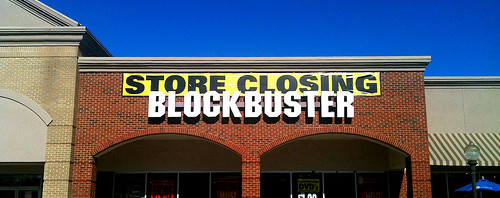“One night or five?” he asked after scanning the copy of “Animal House” I was renting for a night in with some friends. I’ll be honest; I can’t remember the last time I had been inside video rental shop before that afternoon. Growing up, my parents used to take us to the local Blockbuster several times a month to browse the aisles to rent a new flick or a timeless classic. As Blockbuster closes the doors to the last remaining 300 brick and mortar stores in the US, rental shops will soon be a thing of the past.
Like many iconic brands that were established long before the “millennial influence,” Blockbuster’s business model was faced with a challenge as innovative technology entered the scene. We know that millennials see a strong value in useful technology integrated into the consumer experience, so it’s not surprising to see this group of consumers gravitate to digitally convenient solutions. With an established market share, who would have guessed that Blockbuster would find itself becoming irrelevant? But as we’ve seen with so many brands that don’t adapt to cater to millennials, brands that enter the picture with a disruptive schema will win big with this group.
Millennials that grew up with frequenting stores like Blockbuster are finding different ways to rent. As Blockbuster closes its last physical locations, let’s look at how other services are stepping in and winning with millennials.
Redbox entered the scene with the idea that convenience was the ultimate goal video  rental retailers. Using kiosk locations, Redbox was able to take the idea of brick and mortar rental locations and populate a large amount of space by placing kiosks outside of heavy foot traffic big box retailers. By incorporating an easy to use digital display and a consistent price point for one-day newly released rentals, this brand made it wildly convenient for millennials to grab a movie in passing.
rental retailers. Using kiosk locations, Redbox was able to take the idea of brick and mortar rental locations and populate a large amount of space by placing kiosks outside of heavy foot traffic big box retailers. By incorporating an easy to use digital display and a consistent price point for one-day newly released rentals, this brand made it wildly convenient for millennials to grab a movie in passing.
Netflix wanted to offer convenience as well but took it one step further–right to your door to be more specific. Why not just deliver rented movies to the customer? With the subscription-based service, customers pay a once-a-month fee for unlimited streaming content and physical video rental. Not sure how long you’re going to want to keep a video? Hang on to until you’re through, but send it back before you plan on ordering another. Talk about convenient.
While a large amount of Netflix’s appeal is the library of available streaming content, consumers will tell you that Netflix does not have everything. Hulu Plus offers a different library of ready to stream content ranging from your favorite TV sitcoms to award winning movies. How is Hulu Plus even more convenient? Subscribers are able to watch the content on any devise allowing mobile usage wherever you may be.
Author: Greg Vodicka, Assistant Account Manager at Barkley
Leah Swartz contributed to this post.
Photo Credit: Flickr via Tony B. & Jason Kuffer


